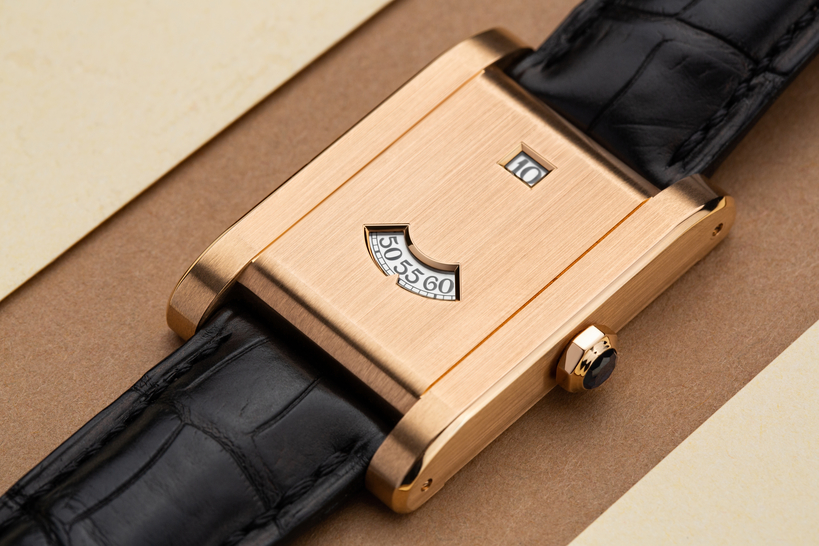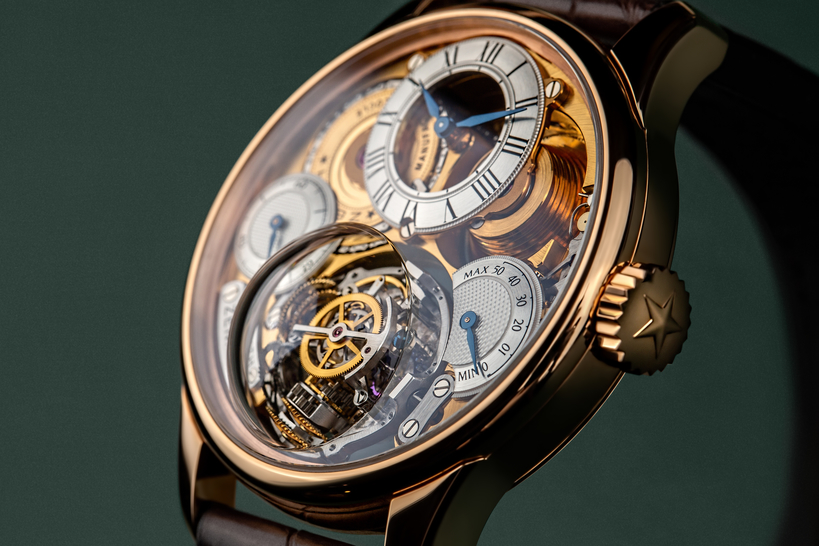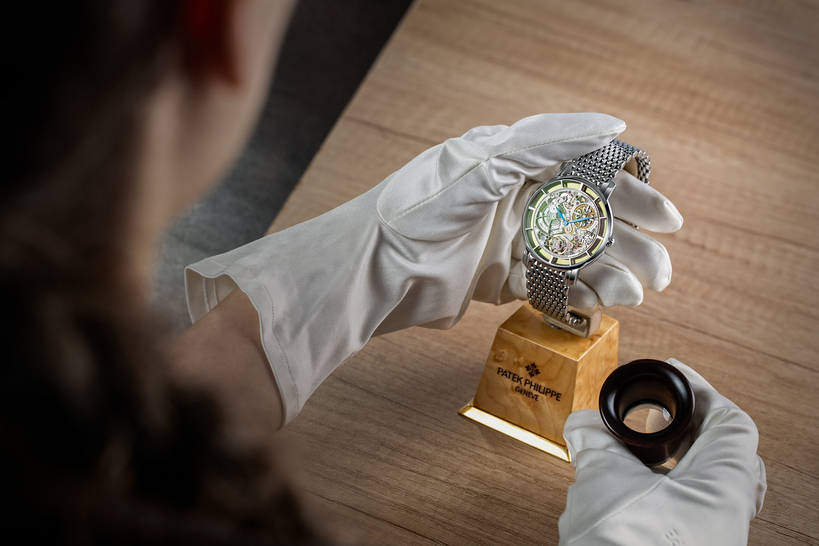The thinnest, most complicated, and most controversial timepieces!
This is our pick of the eight remarkable novelties that surprised us the most last year. And needless to say, all of them have great collection and investment potential.
Vacheron Constantin Les Cabinotiers Berkley Grand Complication Ref. 9901C/000G-B472
The watch of the year in the eyes of the experts was undoubtedly Vacheron Constantin's Les Cabinotiers, commissioned for the American finance mogul William R. Berkley. The Berkley, as the model was immediately dubbed by fans of haute horlogerie, remains the most complicated watch in the world to this day.
Its white-gold case measuring 98 mm in diameter and 50.55 mm in height houses Caliber 3752, assembled from 2877 components. The hand-wound piece has a 60-hour power reserve and a record-breaking 63 complications, which require a total of 31 hands and 9 disk indications.
It took three master watchmakers eleven years of research and development to create the watch. The main premiere among the 63 complications was the world's first Chinese perpetual calendar, which was accompanied by a Gregorian perpetual calendar, astronomical indications, and business calendar.
The main challenge for the developers of this timepiece was the mechanical algorithm for the Chinese system based on the 19-year Metonic cycle, where the length of months and years is determined by the movements of the Sun and Moon. For example, the Chinese lunisolar calendar needs the addition of an intercalary or embolismic month every two to three years.
They're calculated using a 60-year sexagesimal cycle, and the famous 12 Chinese zodiac animal signs are just one of the calendar's functions. Chinese New Year falls on different dates each year. And that's another challenge that means William R. Berkley will need to visit Vacheron Constantin once every twenty years to have the Lunar New Year display disk replaced.
That doesn't cancel out the challenge of February 29 once every four years either. The watch also has a carillon Westminster chiming function with five gongs and five hammers, an alarm, a split-seconds chronograph, along with a spherical armillary tourbillon.
The chart illustrated on the dial doesn't depict the starry sky over New York, instead it shows the sky over Shanghai — clearly in recognition of the first Chinese perpetual calendar. The price of the masterpiece hasn't been publicly disclosed, but it's rumored to be in the region of USD 10 million.
Patek Philippe Cubitus
Patek Philippe's October premiere of a sports watch in a square case came as a huge surprise to all fans of the grand maison, apart from the insiders, of course. On the day of the premiere, President of Patek Philippe & Co. Thierry Stern really highlighted that he'd been dreaming of launching a square watch for over a decade.
And the Cubitus was to be the manufacture's new entry-level watch. This would suggest that the company's president already had a clear vision of the watch that would replace their bestselling steel Nautilus Ref. 5711/1A before it was discontinued four years ago. And as it happens, Patek Philippe began working on the Cubitus four years before its launch.
Cubitus is in many ways the Nautilus successor model. This is both in terms of how the case is constructed (a two-part construction with a cover that opens to the left), and its height of 8.3 mm. The same automatic Caliber 26-330 S C with central seconds, grand date, and it's a full rotor automatic. Like the dial, the rotor is also embossed with the same horizontal stripes.
Even the dial of the Cubitus Ref. 5821/1A-014 is the same olive-green tone as the last serially produced steel Nautilus Ref. 5711/1A-010. Last but not least, it has a very similar price: CHF 35,000 for the 5821/1A-001, while the last 5711/1A-014 retailed for USD 34,893. Yet the Cubitus is actually a totally distinct collection, and one that the Patek Philippe's line was really missing.
The uncompromising square is better suited to sports models than the oval. Besides the Ref. 5821/1A, the new collection also offers a more luxurious Cubitus Ref. 5821/1AR version with a deep blue dial and rose-gold central links on the bracelet. This version retails for CHF 52,000.
About the bracelet: it's smashing. The bracelet it flexible with rounded links that flow into each other beautifully. It's the best metal bracelet by Patek Philippe and one of the best on the market in general. Special decoration for the movement was also developed for the Cubitus. Before the Cubitus, only models in the Grand Complication class were given this honor.
Most of the four years of development were spent working on the new movement for the oldest all-new model in the collection: Patek Philippe's Cubitus Instantaneous Grand Date, Day and Moon Phases Ref. 5822P-001. We're talking about the automatic manufacture Caliber 240 PS CI J LU, where the grand date and moon phase indications are joined by a hand indication for the days of the week.
The main difference that sets this new movement apart from previous versions of Caliber 240 is that the calendar is an integrated construction rather than modular, and all calendar readings jump instantaneously at midnight.
In order to ensure that the work of the calendar doesn't impact timekeeping accuracy, the mechanism uses a system that protects the watch movement from dynamic shocks (especially when the grand date's disks switch from "31" to "01"). Almost 200 components were added to the Cal. 240 base movement in the process, bringing the number of parts up to 353. The complicated Cubitus will be priced at CHF 75,000.
Rolex Perpetual 1908 Ref. 52506
The Rolex Perpetual 1908 model in a 39-mm platinum case with the ice-blue dial characteristic of platinum models sent out a very clear signal: Rolex has decided to enter the market for classic black-tie dress watches.
And it must be said that even considering the fierce level of competition in this market, with the likes of Patek Philippe's Calatrava and Vacheron Constantin's Patrimony as competitors, this doesn't appear to be a hopeless endeavor. To name just one reason, Rolex is asking for USD 30,900 for its platinum model, while starting prices for competitors' platinum models tend to be CHF 50,000.
You have to agree that retailing for half the price is a serious trump card in the battle to win buyers over. And of course, the Rolex 7140 movement is decorated just as lavishly as bestsellers by Patek Philippe and Vacheron Constantin, only smart automated machines have also run over the bridges and surface of the movement by Rolex to give it a rather solid appearance.
However, the dial of the Perpetual 1908 Ref. 52506 is guillochéed with a hand-operated machine. So the Perpetual 1908 Ref. 52506 will grow more valuable over time as the first watch by Rolex with a guilloché dial.
The company goes into more detail about the traditional dial decoration they've chosen: the dials are engine turned the same way watchmakers in the 18th century would configure a graver on a typical lathe, then manually set it in motion. This is at a modern ultra-high-tech facility, where everything is done to minimize contact with error-prone human hands.
The latest caliber 7140 was also the first to combine the trademark Syloxi silicon hairspring with a patented Chronergy escapement. The resulting "Superlative Chronometer" movement runs at a frequency of 4 Hz (28,800 vph) with a 66-hour power reserve. What we have as a result is the most attractive watch in every sense of the word, and a fresh piece on the dress-watch market.
F. P. Journe Chronographe FB
François-Paul Journe also treated his fans to a big surprise last year. For the 20th anniversary of the F. P. Journe Boutique in Tokyo, the maestro presented the classic F.P. Journe Chronograph FB. This is Journe's first hand-wound two-pusher chronograph with flyback function (no split-seconds), hence "FB" in the model name.
It was preceded by the automatic Octa and manually wound monopusher LineSport Chronographe Monopoussoir Rattrapante. Moreover, this is a brand-new model with a new 1518.2 movement that runs at a frequency of 3 Hz (21,600 vph), and it has a very decent power reserve of 80 hours.
The availability has also astonished fans: a whole 200 pieces. Before this watch, availability of Journe's limited editions was capped at a maximum of 99 pieces, because the master apparently hates three-figure limits on his watches. The watchmaker also suddenly announced that this series would be his last ever limited edition.
At the same time, Journe promised not to make any more pieces based on this movement after the 200 Chronographe FB watches, not even his much cherished Souverain watches. The Chronographe FB has a very unusual dial with pad-printed salmon numerals set against a dark gray backdrop with partially opened 60-second and 60-minute chronograph counters.
The 40-mm case is made of polished titanium and with the chronograph pushers and winding crown in rose gold. François-Paul Journe's new chronograph, as non-conforming as the watchmaker himself, is priced at CHF 90,000 (excl. taxes).
Greubel Forsey Nano Foudroyante EWT
The company Greubel Forsey, whose ownership reverted back to Robert Greubel and Stephen Forsey just days ago, also marked its 20th anniversary with an outstanding anniversary premiere. The Nano Foudroyante EWT is the creative duo's first flying tourbillon in their joint career, and it's also Greubel Forsey's first chronograph and smallest watch.
Its case made of white gold and tantalum measures 37.9 mm in diameter. The abbreviation "EWT" also holds great significance. It stands for "Experimental Watch Technology":the name of the experimental manufacturing laboratory that Greubel and Forsey use to create their most complicated mechanisms in their watches. This is the first time it's been used in the model's name.
The company's founders call this premiere their "10th Fundamental Innovation." The movement's construction, protected by two patents, features nearly microscopic drive-wheel nanoteeth. The size and profile of these teeth not only ensure reliable grip, they also ensure a highly effective transfer and distribution of energy.
So in comparison to the traditional foudroyante (flying seconds hand), which needs μJ (microjoules) to make a 1/6-second jump, the Nano Foudroyante mechanism uses just 16 nJ (nanojoules) to make the same jump, reducing energy consumption by a factor of 1,800.
The matte silver-tone dial with a contrasting black-lacquered hour ring and minute scale provides basic hour, minute and small second indications, which are also accompanied by the chronograph functions (seconds and a 60-minute counter), and a 60-second flying tourbillon with a 1/6 second Nano Foudroyante indication over its carriage.
If Greubel and Forsey's further experiments in this area are a success, then sooner or later, they'll be able to create a mechanical watch with a huge power reserve without having to invent any miracle alloys.
But for the time being, this model with a regular mainspring barrel has exactly a day's worth of power reserve, despite the presence of a chronograph module, tourbillon, and the foudroyante hand driven directly by the two almost microscopic drive wheels underneath the escape wheel, which is not too bad at all.
The watch's traditional features, typical of Greubel Forsey, are its design, the price of CHF 465,000, and the ultra-limited edition of just eleven pieces in the whole world.
Rexhep Rexhepi Chronomètre Contemporain II With Ruby Indices
New collector's idol Rexhep Rexhepihas has released yet another version of his magnificent chronometer. Now the model comes in a rose-gold case that measures 38 mm in diameter and 8.75 mm in height with an enamel ivory-colored dial. It has large stretched-out indices made of trapezoidal rubies at ten-minute intervals apart from the 6 o'clock mark.
What makes this model special for fans is the fact that the case has been made by the famous modern casemaker Jean-Pierre Hagmann, which is confirmed by the "JP" hallmark stamped on the lugs securing the strap.
Rexhepi recently signed a contract with the master in his mid-eighties, who now makes cases exclusively for Akrivia. It still houses the same manually wound RRCC II movement — magnificent both in terms of how it has been constructed and finished. The movement has a balance frequency of 21,600 vph and a 82-hour power reserve.
We were surprised by this fact, as well as how bravely Rexhep Rexhepi experiments with the design of classic watches, which theoretically don't leave much room to let the imagination run wild. Suffice to say, fans of the microbrand have proclaimed this novelty the best watch of our time. We don't want to argue with them, but we'd say it's one of the best. The model was launched as a limited edition of 10 pieces priced around CHF 100,000 a pop.
Ming 20.01 Series 3 Chronograph
The most surprising novelty at the beginning of last fall was a chronograph by the independent watchmaker Ming Thein. Some critics have already hailed this watch Thein's best creation. The watch's design reflects Thein's own personal take on haute horology: ultimate simplicity, yet a very, very complex and perfected timepiece.
The manually wound Agenhor for MING Agengraphe Cal. 6361.M1 movement housed in the model was developed by none other than Agenhor's Jean-Marc Wiederrecht.
Watches by the founder and owner of the company Agenhor have been acknowledged with more than one prize at the Grand Prix d’Horlogerie de Genève (GPHG), and he himself was proclaimed watchmaker of the year when the jury of the 2017 Prix Gaïa acknowledged his exceptional contribution to the development of horological complications.
The Ming 20.01 Series 3 Chronograph is a so-called central chronograph, where the entire dial of a model is used as the counter. Additional chronograph hands are also mounted on the central axis to count the seconds and minutes. This time, MING also surprised us with a wonderfully finished movement.
Thein wanted his watches to be on par with the best examples of hand-finished movements by the likes of François-Paul Journe and Michel Parmigiani. The extremely complicated dial on last year's debut was made of borosilicate glass with 600 rectangular cavities filled with specially developed liquid Super-LumiNova X1 lume.
These cavities radiate out to form a vortex-like pattern that changes appearance depending on the angle from which you view it. Oh how it glows in the dark! The glass with its vortex pattern sits on top of a patterned titanium mainplate. The case measuring 41.5 mm in diameter is available in rose gold or grade-5 titanium.
It's amazingly comfortable to wear, assembled from 34 components, and decorated with four different finishes. Even the strap is distinct here, which has a special buckle from the famous workshop Jean Rousseau Paris. Thein only intends on making 20 of these watches, each priced at CHF 43,500.
Konstantin Chaykin ThinKing
Russian watchmaker Konstantin Chaykin set a record for the world's thinnest mechanical watch. Konstantin Chaykin unveiled his ThinKing last year in a 40-mm steel case measuring 1.65 mm in height! Two world records for thin watches were beaten in 2024: first Richard Mille's record was beaten, whose RM UP-01 Ferrari model measured 1.75 mm in height, and then Bulgari's 1.70-mm Octo Finissimo Ultra COSC.
Generally speaking, these types of records for leanness are fairly dubious, and the race in pursuit of ever-thinner watches in and of itself is essentially more of a competition to determine who makes the most reliable watches among watches that are generally reliable anyway.
On the other hand, the discoveries applied to create these watches make a big theoretical and practical contribution to the development of microengineering, materials science, and the study of the strength and structural performance of materials. The mainplate of Konstantin Chaykin's in-house К.23-0 movement also serves as the watch's caseback.
On top of the thinnest of brass bridges, a second dial plate also serves as the case's cover. The main challenge in ultra-thin watchmaking is the height of the balance spring and mainspring barrel, which the watchmaker has re-engineered here. Chaykin's barrel doesn't have gear wheels or a cover, the role of walls is essentially served by a gear ring, and it has a pawl and flat mainspring system built into the barrel-arbor instead of a ratchet wheel locked by a click on top.
Moreover, the spring and pawl have been made as one component. An unusually elegant and promising solution! Konstantin Chaykin's new double balance system will inscribe the watchmaker's name in the history of haute horlogerie. The watchmaker broke the classic balance-wheel architecture down into two levels.
Chaykin refers to one of them as the main balance wheel, because it's the one that determines the frequency and isochronous oscillation. The second is the roller balance wheel, which combines the impulse jewel and engages with the pallet lever to unlock the escapement. The balance and roller are connected by the teeth around the edges of the wheels.
It's an ingeniously simple and effective solution! If the wheels were made of silicon- or nickel-based material using the DRIE photographic manufacturing method, it would minimize the force of friction and energy loss. Then few would be able to compete with this escapement on efficiency and reliability.
In the long run, Chaykin's two-level regulator assembly could reduce wristwatches and interior clocks to a fraction of their size, not to mention slimming down timekeeping instruments in other fields of engineering. Chaykin also developed a suspension mechanism to secure the strap to the case.
Stress on the case is transferred onto titanium supports and a pair of elastic inserts sewn into each side coming out of the case. As a result, the case doesn't get bent, and links in the gear train don't become crooked. There's no winding crown on the watch case. An additional PalanKing carrier case comprising 44 components was developed for the ThinKing to wind the movement and adjust the hands.
Imagine your smartphone had a case with additional buttons you could press to activate extra features. After all, the PalanKing also has its own micro-rotor and integrated winding mechanism to convert the watch into an automatic movement. In a way, this is a creative development of the Sympathique clock designed by Abraham-Louis Breguet in 1793 and his famous "symbiotic" watch and clock concept.
Credits provided by: www.vacheron-constantin.com, www.patek.com, www.rolex.com, www.fpjourne.com,
www.greubelforsey.com, www.hodinkee.com, www.ming.watch, www.chaykin.ru




























